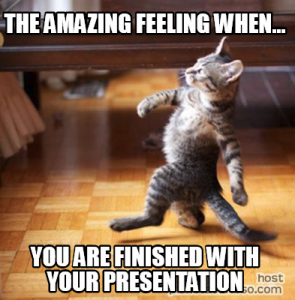PART 2 – Consulting U: The Rundown On IT Consulting
9 Chapter 10: Presentation Phase
WHAT Presentation means
You’ve put tape around that problem. You’ve worked tirelessly at researching. You’ve reached that Frankenstein moment when you finally found those potential solutions. Now, it’s time to show this bad boy off. The Presentation phase is your proud moment to showcase all of your hard and (no doubt) amazing work to the main client stakeholders on your project.
WHEN Presentation Happens
Have you found the perfect solution for your client’s business problem? If the answer is ‘yes’ you probably can’t even contain your excitement and you know it’s time. The presentation typically happens at the end of the second Capstone term and there will be anywhere from one to a number of presentations, depending on how many separate audiences you have.
WHO Presentation Involves
This isn’t the chance for anyone to shy away. It’s your shining moment to show off what you’re most proud of, so start practicing early to hone in on your passion for what you’ve invested in with your everything for the past 8 months.
Every member on your team should play a role in presenting key takeaways and important points to your client and to your professor. Bonus if you can present to both at once. On the client side, you’ll most likely have the project sponsor, decision makers, and anyone else who’s excited about your project at your presentation.
WHY The Presentation Phase Is Important
The Presentation phase is your opportunity to communicate the juiciest of project details to those who need to know. Sure, your client can very well read the executive summary in the report, but that certainly isn’t as entertaining as watching a team of people breathe life into those words. It’s also a better way to get client approval for the project to continue on. Getting buy in from your client is a definite mark of success. It’s a way of telling you, “We heard you. We like it! Let’s make it happen!”.
HOW to Navigate Through Presentation
The presentation phase is when you share the analysis, findings, and solution to the stakeholders at your client company. It is important to be prepared to share what you have learned and be ready to answer any questions that the presentation may trigger from the client.
As you approach the big presentation day, there are a few things you should consider so that you’re ready, set, go.
1. Before presenting to a large number of stakeholders, it is recommended that you meet with the primary stakeholder for initial feedback first. By providing a ‘preview’ to the main stakeholder of the solution and the content you plan to present, you both will be in a more confident place when presentation day arrives. You will know that you are aligned and have the support of your primary stakeholder, and they are already privy and reassured by what will be shared with the rest of the stakeholders. It’s also possible that the stakeholder will make suggestions on how you can improve the way the proposed solution will be received by the larger group.
2. Be prepared to speak at length about why other potential solutions were NOT chosen. As much as its logical to focus on why the chosen solution is being recommended, buy-in from stakeholders will come as a result of understanding why other ideas are not suitable. The larger group may be coming in with preconceived solutions or expectations of what the right direction may be. By being able to communicate the lesser benefits of other solutions, the stakeholders will be better positioned to provide buy-in.
3. For the presentation, engage with the audience by using a well designed slide deck, making eye contact, speaking loudly and clearly, exuding energy, asking meaningful questions, etc. This will allow them to see the commitment you have made to this project and how much you really care about understanding their needs and the landscape around them. In addition to presenting the analysis and solutions, also give insights into the implementation plan. Consider using the BOPPPS framework to help you determine the flow of your presentation.
4. Show respect for everyone’s time. By having an agenda slide at the beginning of your presentation and some sort of visual progress indicator shown throughout, you’re allowing the audience to form a mental map of your presentation and avoid the common distraction of wondering when the presentation is going to end. It’s also very important to stick within the time limits that have been established for your presentation. If you’ve agreed to a 15 minute presentation and a 5 minute Q&A session, no amount of effort or speed talking will do you any good if your presentation deck is 30 slides. No, not even the superhero Flash could accomplish this feat. As the famous saying goes, “know your limit and stay within it.”
5. Get ready for questions. In fact, you’ll do yourself a great favour by anticipating the questions you may get asked and having answers ready for them. This is also an opportunity for the quieter members on the team to weigh in on the ‘conversation’.
6. Be open to feedback and make sure you’re ready to document it while it’s coming at you. You’ll need this feedback to make any necessary revisions prior to finalizing your report. If you don’t make the effort to get prepared for this, the jitters might get the better of you during the presentation and it’ll be difficult to remember all of the feedback and questions you had received. Be diligent to review the feedback gathered before making the report revisions. Use the knowledge and understanding that you have gained over the course of the project to determine which feedback warrants revisions. Determine the best approach to modify the findings in your report, to make the solution better, and to validate the final offering/idea.



Feedback/Errata